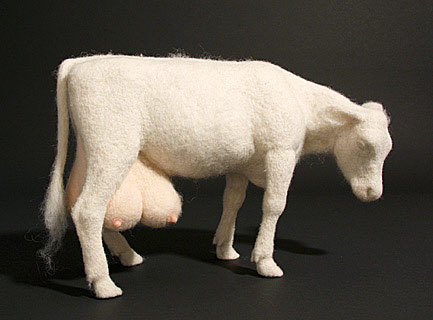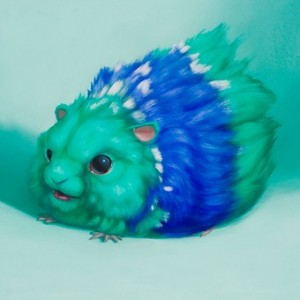
Do Science and Art Really Meet?
Despite several formal high points, and some strong visuality, another show purporting to have artists talk deeply on science, well, bears out something Steina said 10 years ago. When the subject of the mutual inclination between artists and scientists comes up I think of a long-ago symposium held at SITE Santa Fe that sat some of those distinguished people next to one another along a dais.

Laurie Hogin "Pharmaceutical Guinea Pigs: The Most Heavily Marketed Hypnotics" 2008
Rapt at ground level, we the capacity audience then listened to each of them (and there were probably 16) opine as to where art and science meet, if they do. Joseph Kosuth explaining his conceptual art life was a high point for me of that gathering, although what I best remember is Steina in her this-is-a-waste-of-time way declaiming that artists and scientists have nothing in common at all.
By way of preface to Artificial Selection at 516 Arts, a show which takes a playful approach to a subject so increasingly serious as to make even Bill Maher turn off the news, all this really offers is that as the premise of a contemporary art show in atomic New Mexico, the meeting of “art, science, myth, and technology” is a huge subject.
And, typically, faced with the bigness, a bunch of artists do what artists often do when “interpreting” science – envision and craft imaginariums. They often choose qualities of visual make-believe over conceptual headiness. And the relative formal comforts of the first turn shows like this tricky in that, under the elevated mantle of art interpreting science, what gets cheated in the hard striving for inter-disciplinary confluence, is the rigor of critical differences. To Steinas point. Artists are not scientists. Scientists are not artists. Being really creative is indeed the mutual factor, but creativity does not always net art, and being an artist does not make one able to discuss particles with a physicist. Just because my basset hound looks like a crocodile doesnt make her one.
Here, curator Rhiannon Mercer selected shy of two dozen artists for the two floors of the clean Albuquerque space. Take it in first by a walk through. Then: Don skates in your art-historical memory or imagination. Mine finds me circling the rims of Hieronymous Bosch paintings for the deepest weird science in the history of art. Thats me. Thats. 1503.
For shows that are art but have actually showed hard science, Id give Thomas Ashcraft the MacArthur, if I were queen. He turns art installations sense-surround by activating smell, hearing, taste, touch as well as sight. He conducts radio astronomy out of his Tuff Shed and actually knows when moons of Jupiter aurality is likely to be picked up by antennae pointed at New Mexico sky.

"The Garden of Earthly Delights" by Hieronymous Bosch
I guess this goes to my beef, ultimately. That, in aggregate, it is hard for art wishful about science not to become a cliff note with political freight that in sum takes it all down a notch. The same is so of scientists interpreting their theorems visually. I construed this as true of Simon Mehaleks piece on robotics, and it seemed metaphorically apt it was placed (really) too high in the gallery.

Alison Petty Ragguette's "Cross Section and Amnioforms"
To the curators credit, the craft of these disperse objects is excellent, which speaks to the organizing principle of her selection process and then of the installation. And the show as a whole looks good and invites people to enter in, perhaps by virtue of how seductive its surface approachability is. The trouble is that the vectors are predictable. And themes like this should be forced to narrow down else risk PC liteness. Genetic mutations at 80 degrees, craft striving for art cred at 30.
Still. There were highlights of the show for me. On first sight I loved Stephanie Metzs felted wool critters and appreciated she eschewed color for white or that strange hue my mother used to call “bone.” As a concept for a visual project, I also really liked Robert Dorhmanns Davison Grant Genetics simulated biotech company, but the visual content took back row to the wall text.
As a dimension-bending-installation, Alison Petty Ragguettes Cross Section and Amnioforms were the shows strange fruit of choice, while Luke Shaws robots riffing on 70s cartoons hit my nostalgia gene. Painter Heidi Taillefers work is formally excellent, but again, and sadly at the end of the day this show struck me as something that could have been an MFA student show. But the advisors from art history, and Joseph Kosuth, had gone missing.
(Top photo: Stephanie Metz, Milk Cow. Felted Wool. 9 “H x 5″W x 15″D. 2005.)
